
|   |

|   |
Stop over: Amsterdam India and the World: The Performing Arts - Sunil Kothari e-mail: sunilkothari1933@gmail.com Photos courtesy: Prof. Sanjoy Bandopadhyay, Kolkata December 28, 2008 As cultural diplomacy many moons ago, Pupul Jaykar and Prime Minister Indira Gandhi set the ball rolling by organizing Festivals of India abroad, bringing the best of Indian performing and plastic arts, crafts, and every field in which Indian artists have shown their excellence, to the doorsteps of countries like Soviet Union, USA, Europe, UK. The cultural exchange resulted in better understanding of India in the world. Today, India with globalization and acquiring important position as an economic power competing with China, has emerged as a major nation displaying immense confidence in its multi-tasking and playing an important role as a democratic nation. In a series of Festivals of India in recent years in other countries besides France and UK, the interest in Indian culture has resulted in Festivals of India on a smaller scale. Along with the performing arts, academic symposia have been organized by the academic institutions. The University of Amsterdam and its Department of Musicology organized a three-day seminar (19-21 November 2008) at CREA auditorium next door to the University, as a part of India and the World: The Performing Arts in collaboration with Indian Musicological Society, a kind of sequel to the conference that ITC- Sangeet Research Academy organized, Indian Music and the West, further extending the horizon to the whole world looking into the largest possible variety of subjects. Prof. Wim van der Meer, Joep Bor, Rokus de Groot, Pandit Arvind Parikh, Suvarnalata Rao and several others planned the conference two years ago casting their net as wide as possible inviting Afghan, Iranian, African scholars and included screening of films relating to music on a scale which indeed was mind boggling. 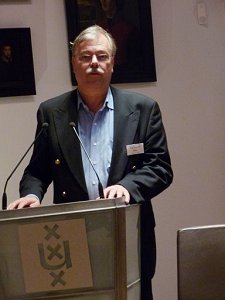 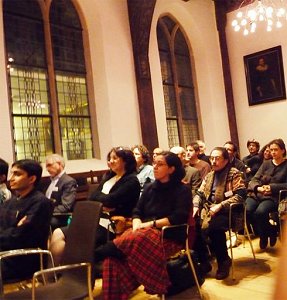 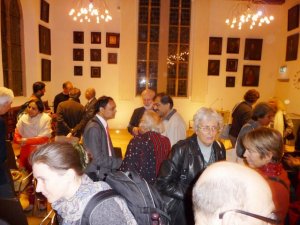 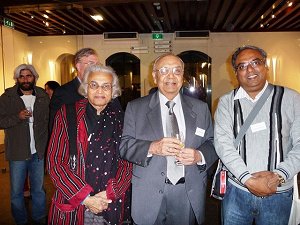 Dance being an important component, its relation to music and also as an independent art, how it has over the centuries created impact and interest in Europe and beyond, was discussed and a whole day was devoted to various aspects of Indian dance including some aspects of drama. The highlight of the seminar was a special lecture on The First Indian Performers in Europe - the European tour of five Indian temple dancers, 1838-39 by Joep Bor, a brilliant scholar, known for his seminal work on Sarangi, presently a professor of Extra-European Performing Arts at Leiden University. He is the founder of the Indian music department and later the world music department at the Rotterdam conservatory. His wife Durga Bor is an Odissi exponent. 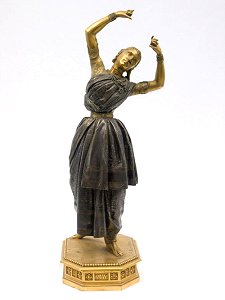 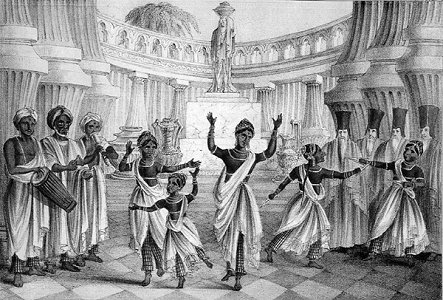 In London, they danced 55 times at the Theatre Royal Adelphi, and approximately 60 times in the Egyptian Hall. What do we know about 'these enchanting Bayaderes' who were 'the chief magnets of attraction' and 'greatest curiosities' in Paris, London, Brussels and other European cities? How did the press portray them, and what was the response of European audiences to Indian dance and music in the late 1830s? Joep in an engrossing talk, gave historic and most valuable information in a lecture which was riveting and generated great interest amongst musicians, music scholars from India and dancers, dance scholars from abroad. 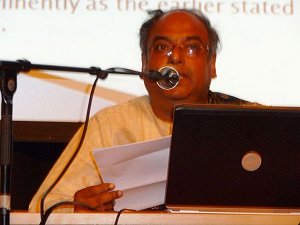 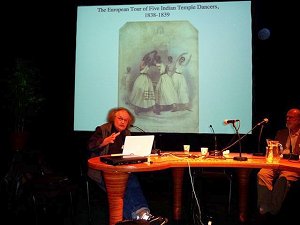 Tiziana has studied ballet and contemporary dance at the National Academy of Dance at Rome. Her dissertation on Indian dance submitted to University of Bologna is awaiting publication. She spent 12 years in India for research, learning Bharatanatyam and Odissi under guidance of V S Muthuswamy Pillai, K Nagamma, K Pattammal, K Venkatalakshamma and Guru Kelucharan Mahapatra. Her articles and monograph entitled Devadasi and Bayaderes: between History and Legend, Indian dancers in Western travellers' accounts and Theatre plays, gives important documentary evidences about Indian dance in Europe. Her illustrated lecture 'From Mata Hari to La Meri: Modern 'Hindu Dancers' in India and the West: A Mutual Exchange' (1905-1946) with rare photographs covered some of the area which has been covered by Mohan Khokar, Uttara Asha Coorlawala and myself. She referred to my photo biographies of Uday Shankar and Rukmini Devi and various illustrations, photographs I had placed juxtaposing contemporary dancers from abroad who had shown interest in Indian dances. The illustrations of performances during the 'Exposition Universelle' in Paris (1900) were quite interesting. She emphasized that both Uday Shankar and Rukmini Devi became influential through their dance schools at Almora and Adyar in Northern and Southern India. The celebrated renaissance of the Indian dances was a recasting of aesthetic patterns taken both from India and the West. Meanwhile some Western dancers like Simkie, La Meri and Ragini Devi learned from local hereditary masters before spreading the knowledge of Indian dance in the world. Jetty Roels, a Belgian dancer, who had shown some of these slides during her talk at the Natya Kala Conference a few years ago at Chennai, runs Natyaveda, a school for Bharatanatyam at Brugg. She has also done in-depth work in this area. She organized Dance Round Table in the afternoon inviting me, Dr Saskia Kersenboom, Kalpana Raghunathan, Tiziana Leucci, Savita Bonoo from Surinam, now settled in Amsterdam and others discussing various aspects of research practice, journalism, contemporary dance development, guru-shishya parampara and history of Indian dance and Hindu community in The Netherlands. It was refreshing to learn about the Indian Diaspora from Surinam moving to the Netherlands and studying Indian classical dances. It was regretted by all that the space in print media was shrinking for dance criticism. I drew attention to narthaki.com e- journal and Nartanam quarterly which covers dance and also reviews. The newspapers (except for The Hindu in India) have practically given up dance criticism world over. Saskia Kersenboom, the author of Nityasumangali, and a disciple of Nandini Ramani, in Balasaraswati's bani (style), gave an illustrated talk on Nataraja's global stage, emphasizing the importance of sthalapurana - the history of the places - for further understanding of cultural references. She further elaborated upon the interpretation of dance of Shiva as explained by Dr Ananda Coomaraswamy, interpreting apasmara, Mulayalaka, the figure trampled by Lord Shiva under his foot, as Lord Shiva's winning over smara, Kamadeva. She observed that the Orientalist notions that attributed a spiritual essence to the dancing Shiva and enthusiastically accepted and further elaborated upon by post-colonial Indian national discourse is diametrically opposed to the ritual practices in Hindu temples of Tamilnadu. She showed an interesting video of the temple rituals to support her observation. Durga Bor studied Odissi under Surendranath Jena and later on under Kelucharan Mahaptara. She taught and performed Odissi for a number of years in Amsterdam and then moved to Cornell University, where since 1995, she has been teaching Indian dance and South Asian dance history. Her exposition of continuing transformation of Odissi was based on her regular visits to India and keeping in touch with the latest trends and developments. 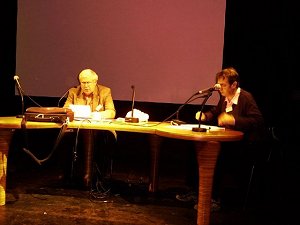 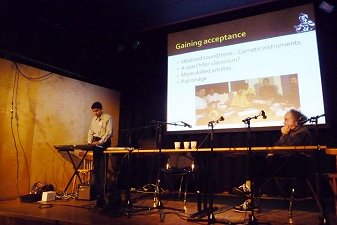 'Watching the Nautching' by Margaret Walker from Queen's University, Kingston, Canada, dealt with European patronage and perspective of Indian dance throwing interesting light on Kathak as mentioned in several records of European and British travelers, writers, officers during the Raj period. She has to her credit her thesis on Kathak Dance: A critical history. Trained in Kathak both in Toronto and at Kathak Kendra, New Delhi, her research work is sound, scientific and succeeds in establishing an interesting context. 'Dance, diaspora and difference' by young Bharatanatyam dancer and musician Meera Varghese from the University of Alberta, Edmonton, Canada, dealt with the experience of Indo-Canadian communities providing insights into the function of traditionalism in minority communities and how this relates to changes in the social function of expressive culture in Canada. She is now pursuing western music at Köln, Germany, under a fellowship but continues her interest in classical dance. Hers is a case of Canadian Indian generation which sustains as bearers of cultural traditions within diasporic communities. A fascinating presentation on Kudiyattam was by Heike Moser who has studied Nangiar Kuthu and Kudiyattam at Kerala Kalamandalam (1995-2001) and performs regularly. Assistant Professor at Tübingen, Germany, Heike's DVD presentation stressed the fact that modern Kudiyattam performance does not focus upon ritualistic elements, but has shifted towards a theatre of high aesthetics. Her devotion to Kudiyattam was transparent. An important figure in Germany, she has a busy career giving lec-dems on Kudiyatttam and drawing a number of theatre workers to this ancient Indian theatre. 'Innovative diasporic traditionalism: Kathak Yoga' by Sarah Morelli, a disciple of Chitresh Das, explained how Chitresh Das, who has been teaching Kathak in Bay area in San Francisco for the past 37 years, has developed further without having accompanying musicians. In 2004 during a Kathak conference at Chicago, she had with the help of video clippings of Chitresh Das' innovations, in which the dancer himself keeps the 'theka' rhythm, sings lehera simultaneously dancing, executing complex foot work and masters the technique. Kathak Yoga was specially conceived taking into account the needs of diasporic students for concentrated individual riyaz, practice. These presentations gave the scholars an idea of how Indian classical dances are being taught, practiced and perceived abroad. For my presentation on dance experiments by Indian diaspora, I screened works of Ragamala Dance Company run by Ranee Ramaswamy and her daughter Aparna Ramaswamy, based in Minneapolis. They have used songs of the jazz singer Billy Holiday, experimented with Opera music and Carnatic music, story telling, language of deaf and dumb, juxtaposing language of hand gestures, using Bharatanatyam technique and how through their outreach program, they have made Bharatanatyam and Indian culture accessible to Americans and other communities. Aparna and Ranee are trained by Alarmel Valli and have sound training in Bharatanatyam. Their company's work is much appreciated. Besides dance, the learned papers on Indian classical music, film music, instrumental music, interaction between Western and Indian music, were of a very high order and since emphasis was on music, the canvas and range of topic covered several issues including the role and evolution of an archive. Shubha Chaudhuri made an excellent presentation on The Archives and Research Centre for Ethnomusicology (ARCE) in New Delhi, which completed 25 years in September 2007. A wealth of information was made available through charts and figures. Tushar Bhatia from Mumbai regaled music lovers with his presentation of excerpts of film songs in which Western musical concepts are used. It was for some of us, a trip down memory lane with a feeling of nostalgia. Responses  Dr. Sunil Kothari, dance historian, scholar, author, is a renowned dance critic, having written for The Times of India group of publications for more than 40 years. He is a regular contributor to Dance Magazine, New York. Dr. Kothari is a globetrotter, attending several national, international dance conferences and dance festivals. He has to his credit more than 14 definitive works on Indian classical dance forms. Kothari was a Fulbright Professor and has taught at the Dance Department, New York University; has lectured at several Universities in USA, UK, France, Australia, Indonesia and Japan. He has been Vice President of World Dance Alliance Asia Pacific (2000-2008) and is Vice President of World Dance Alliance Asia Pacific India chapter, based in New Delhi. A regular contributor to narthaki.com, Dr Kothari is honored by the President of India with the civil honor of Padma Shri and Sangeet Natak Akademi award. He recently received the Senior Critic award from Dance Critics Association, NYC. |